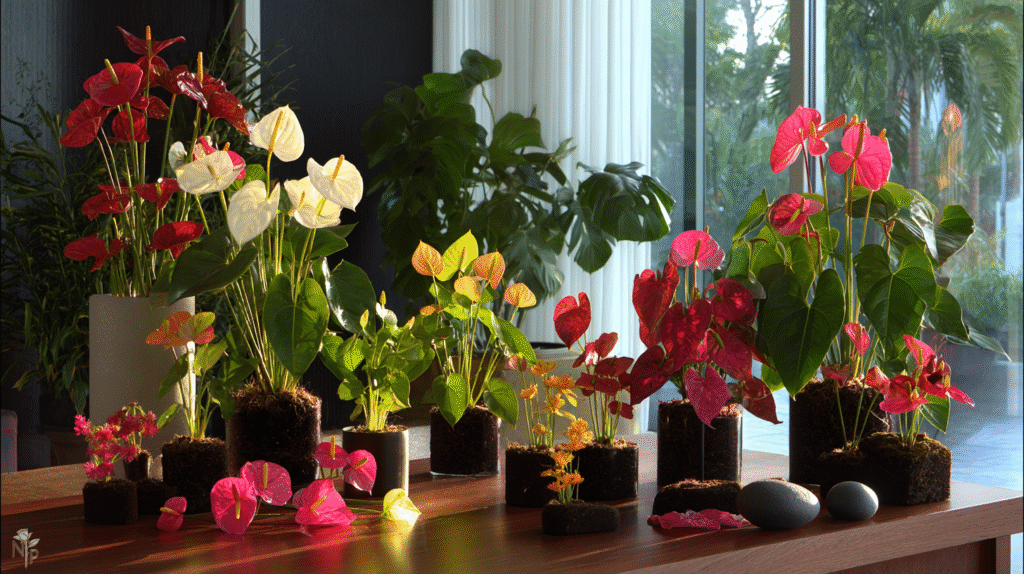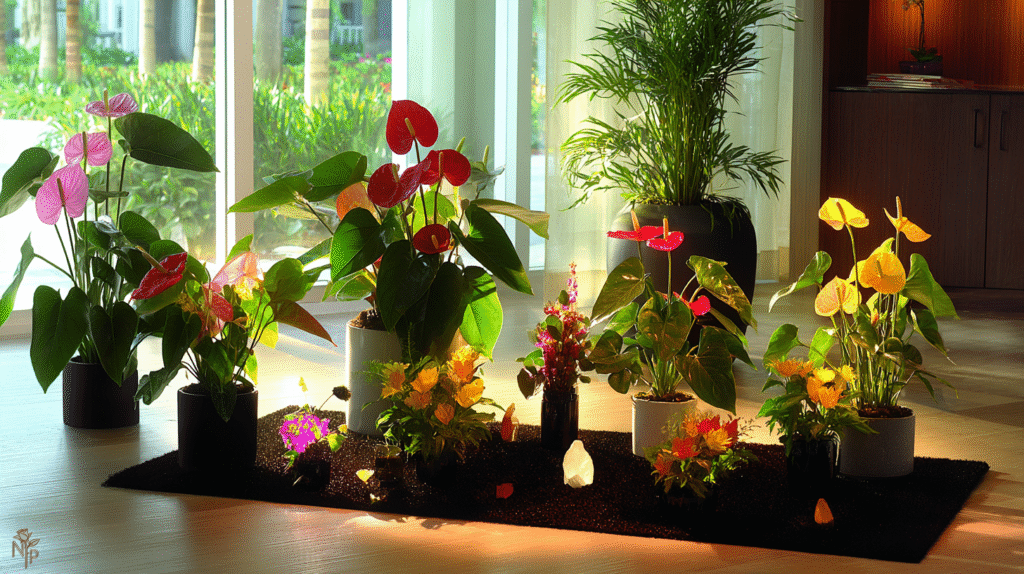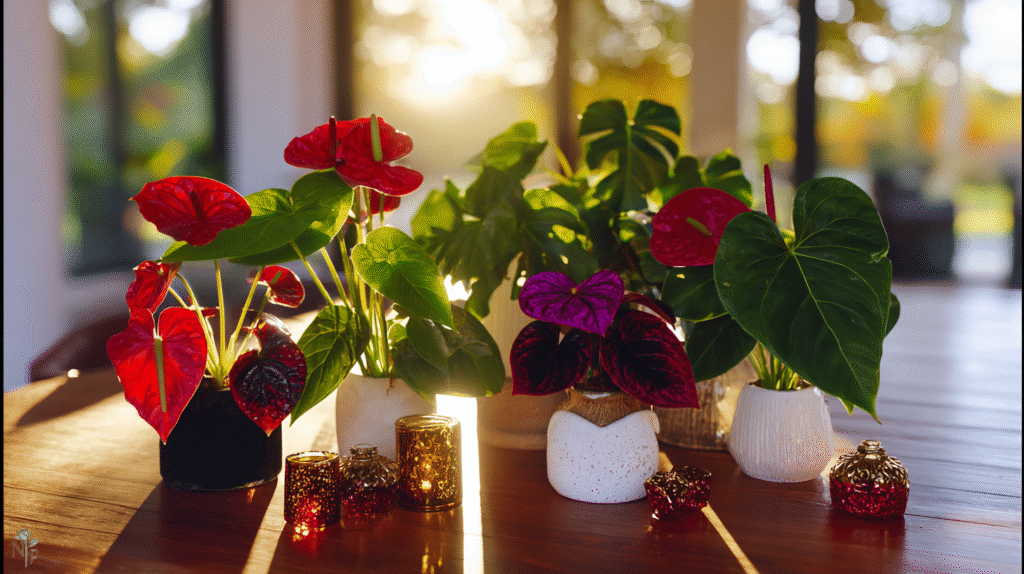The first time someone gave me an anthurium, I thought they were making a statement. Those glossy, heart-shaped red “flowers” seemed almost aggressively romantic — like Valentine’s Day and a marriage proposal had a botanical baby. I actually asked my friend, “Are you trying to tell me something?”
She laughed. “It’s for your new apartment! They mean hospitality and abundance. Plus, they’re impossible to kill.” (Spoiler: I almost proved her wrong on that last part, but that’s another story.)
That gift sparked my fascination with anthuriums — not just as houseplants, but as symbols loaded with meaning across different cultures. Turns out, these tropical beauties have been sending messages for centuries, and most of us have no idea what we’re really saying when we gift them.

From Rainforest to Living Room: A Brief History
Anthuriums started their journey in the rainforests of Colombia and Ecuador, where indigenous peoples knew them long before any European botanist showed up with a Latin name. Local communities used them medicinally and saw them as symbols of protection — those shield-like spathes weren’t just pretty, they were spiritual armor.
The plant world officially met anthuriums in 1876 when Belgian botanist Jean Jules Linden brought them back to Europe. Victorian plant collectors lost their minds. Here was a tropical plant with “flowers” that lasted months, not days. The heart shape? The glossy finish? The fact that they bloomed in the dead of winter? It was like finding plant gold.
By the 1940s, Hawaii had become anthurium central. A Japanese immigrant named Ozaki Takaichi started breeding them, creating varieties that would make their wild ancestors jealous. Hawaii still produces most of the world’s commercial anthuriums, which is why your grocery store anthurium probably has more frequent flyer miles than you do.
What Different Cultures See in That Heart Shape
Here’s where it gets interesting. That same heart-shaped bloom means wildly different things depending on where you are:
In Hawaii: Anthuriums represent hospitality and warmth. It’s the plant equivalent of saying “mi casa es su casa.” Hotels stuff them in every lobby arrangement. Locals give them as housewarming gifts. When my Hawaiian colleague moved to the mainland, she brought three anthuriums with her “to make it feel like home.”
In Colombia (their homeland): They’re symbols of abundance and good fortune. Businesses display them near entrances. New shops get gifted anthuriums like we give horseshoes or lucky bamboo. My Colombian neighbor has seven in her restaurant — “one for each year we’ve been open.”
In Feng Shui practice: Red anthuriums are fire elements that attract love and passion. Put them in your relationship corner (far right corner from entrance) if you believe in that stuff. My skeptical self did this as a joke. Met my partner two months later. Coincidence? Probably. But that anthurium still lives in our bedroom.
In Greek tradition: The name comes from “anthos” (flower) and “oura” (tail), referring to that spadix spike. But Greeks see them as arrows of Cupid. Wedding gifts often include white anthuriums for pure love. Red ones? That’s for the honeymoon suite.
The Color Code Most People Don’t Know
When I started giving anthuriums as gifts, I just grabbed whatever color looked pretty. Turns out, I was sending mixed messages:
Red: Classic choice. Means love, passion, and intensity. Great for romantic partners, risky for coworkers. I once gave my boss a red anthurium for her birthday. The office gossip was spectacular.
Pink: Softer love — friendship, admiration, femininity. This is your safe choice for most occasions. Says “I care” without saying “I’m in love.”
White: Purity, innocence, new beginnings. Perfect for weddings, baptisms, or that friend who just got divorced and needs a fresh start.
Purple: Royalty, luxury, admiration. I save these for people I really want to impress. They’re harder to find and everyone knows it.
Green: Nature, growth, good fortune. Supposedly great for new businesses. My barber has one that’s been blooming for three years straight. His business? Booming.
Orange: Energy, enthusiasm, creativity. I give these to artist friends. One swears her orange anthurium helps with creative blocks. Placebo effect? Who cares if it works.
Modern Symbolism: What We’re Really Saying
Today’s anthurium symbolism has evolved beyond traditional meanings. Here’s what we’re actually communicating:
“I put thought into this.” Anthuriums aren’t impulse buys like grocery store roses. Finding a nice one takes effort. Recipients notice.
“This represents long-term thinking.” Unlike cut flowers that die in a week, anthuriums can live for years. It’s the gift equivalent of saying “I’m in this for the long haul.”
“I see you as sophisticated.” Let’s be honest — anthuriums look expensive and exotic. Even if you got yours for $15 at Trader Joe’s, they seem fancy.
“I want you to think of me often.” Every new bloom (which happens constantly) is a reminder of the giver. My mom still mentions the anthurium I gave her five years ago. Marketing genius or emotional manipulation? You decide.
Cultural Faux Pas I’ve Learned the Hard Way
The hospital incident: Brought a red anthurium to a sick colleague. In some Asian cultures, red flowers in hospitals mean death wishes. I learned this from her horrified mother. Now I stick to pink or white for hospital visits.
The feng shui disaster: Gave my very traditional Chinese friend an anthurium for her kitchen. She moved it immediately — apparently kitchens are water elements and red anthuriums are fire. “You trying to burn my house down?” Lesson learned.
The wedding mix-up: Brought a gorgeous red anthurium to a wedding. In certain European traditions, only white flowers for weddings. Red means you object to the union. The bride laughed, but her grandmother didn’t.

Why Anthuriums Beat Roses Every Time
After years of giving both, here’s why anthuriums win:
Longevity: Roses last a week if you’re lucky. Anthurium blooms last 2-3 months. The plant itself? Years or decades.
Message evolution: Roses say one thing: “I love you” or “I’m sorry.” Anthuriums can mean hospitality, abundance, sophistication, or love, depending on context and color.
Investment perception: Even cheap anthuriums look expensive. Roses? Everyone knows what dozens cost.
Conversation starter: Nobody asks about roses. Everyone asks about anthuriums. “What is that? How do you care for it? Where did you get it?”
The Gift That Keeps on Giving (Literally)
Here’s what sealed the deal for me: anthuriums multiply. My friend still has the anthurium I gave her for her promotion five years ago. It’s produced four baby plants. She’s given them to her team members. Those plants have made more plants.
I accidentally started an anthurium pyramid scheme.
There’s something profound about giving a gift that creates more gifts. It’s like launching a botanical pay-it-forward campaign. My original $20 plant has probably generated hundreds of dollars worth of offspring, spreading whatever good vibes I originally intended.
Your Anthurium Gift-Giving Decoder
Housewarming: Pink or white. Says “welcome” without being overly intimate.
New job/promotion: Green or orange. Growth and energy vibes.
Romantic gesture: Red, obviously. But know your audience.
Apology: White. Clean slate symbolism.
Just because: Pink. Friendly, thoughtful, appropriate for anyone.
Hospital: White or pale pink. Avoid red unless you’re sure about cultural backgrounds.
The friend who introduced me to anthuriums was right — they do mean hospitality and abundance. But they also mean thoughtfulness, longevity, and a dozen other things depending on who’s giving and receiving. That’s the real magic. These glossy heart-shaped blooms are like botanical blank slates, ready to carry whatever message you need to send.

Just maybe check the recipient’s cultural background first. And definitely make sure they don’t have plant-eating cats. Trust me on both counts. 🌺






